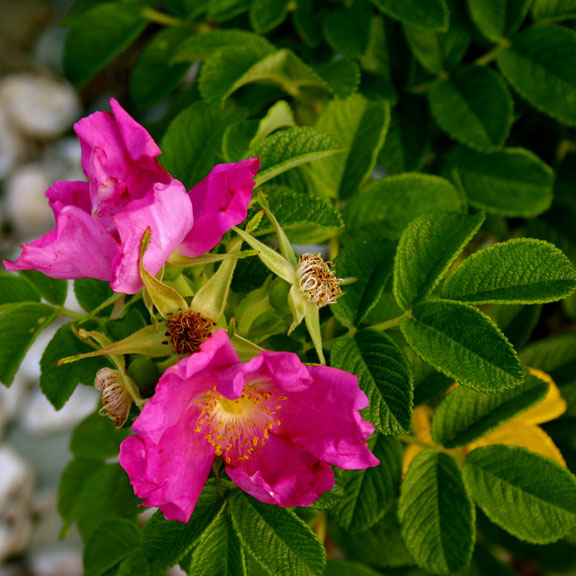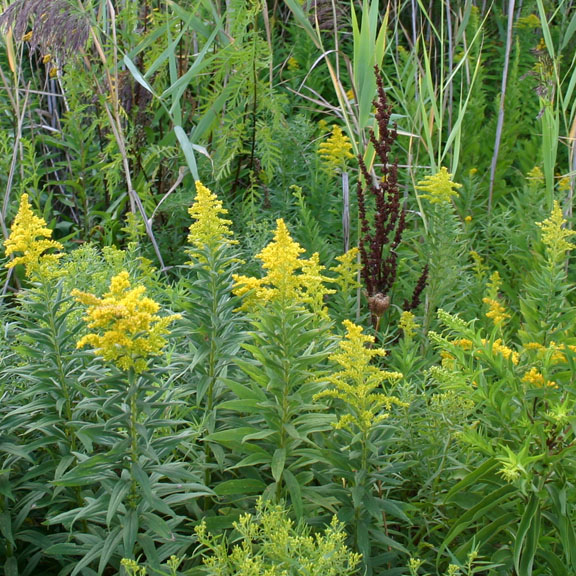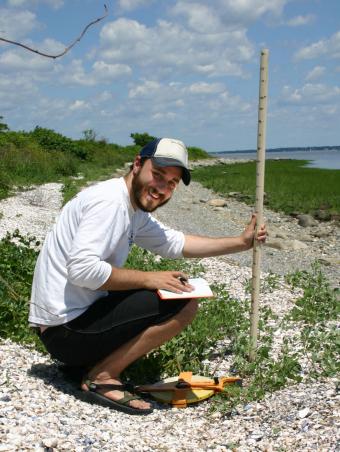Living among our own are aliens and invaders that have changed the very landscape of our shores, and have taken away vital resources such as food, water and … light. Such is the real, palpable fear that many people harbor on behalf of native plant species.
Ecologist Matthew Heard has a hopeful message for those people: “We may expect that some [exotic] plant species can have an impact, but by and large we’re not seeing that happen. We see that they are adding to diversity. They are not always being detrimental.”
The evidence is in the dissertation that will earn Heard a Ph.D. in ecology and evolutionary biology in May. What he found in coastal communities of southern New England — and confirmed by reviewing dozens of studies from around the world — is that coexistence is the norm and extinction is the exception.
It’s not that alien plants come in peace, exactly. It’s just likely that they’ll end up in balance. For that reason, it could be a waste of money and time for people to regard every exotic species as a threat to be countered. “The most important thing is to try to eliminate the automatic xenophobic reaction,” he said. “The idea that exotics are inherently bad and are always going to cause a problem is a myth in a certain way. With that in mind, we should try to focus on the things that do cause problems.”
Botanical balance
Forbearance for flora defies a certain intuition. Isn’t ecology a harsh competition for the survival of the fittest? Doesn’t the taller plant get the light? Isn’t this a zero-sum game? Heard readily acknowledges that some exotic plant and animal species have made themselves unwelcome. As an undergraduate at the University of Tennessee, for example, he bore witness in the Great Smoky Mountains National Park to a die-off of hemlock trees caused by the Hemlock Wooly Adelgid, a hungry Asian aphid.

But ecology is often not as simple as rapacious predator meets defenseless prey. There are ways for such battles to persist in stalemate.
For this thesis work at Brown, Heard observed that happen along the beaches of Rhode Island and Massachusetts. Naturalists had been keeping track of new and native species since the 1800s and, more recently, John Bruno, a preceding student in the department, had been keeping rigorous records of plant populations. The focus was on the strandline, that salty border where dry land meets the beach.
Adding his own observations over the last five years to those of Bruno and the naturalists before, Heard established a long-term and near-term picture of the plant species. As exotics like the Salt Spray Rose appeared on the strand hundreds of years ago, natives like the Seaside Goldenrod stayed put. It is impossible to say that no natives have ever died out, but on the whole they’ve remained.
“You often would see them next to each other,” Heard said. That was true of hundreds of natives and exotics alike.
“What we saw was that exotic species were increasing in dominance, but that didn't have any impact on the native plants,” he said. “Nothing that we know of has dropped out. Nothing went extinct locally in response to these increases.”
Either the plants had to be so different from each other that they wouldn’t compete, or for some reason the competition didn’t produce winners and losers as the zero-sum-minded would insist. To find out why, he did some experiments.
In one experiment, Heard decided to see if they were indeed competing with each other. He weeded away the exotics from around natives in some patches, and removed the natives away from the exotics in others. Sure enough, removing exotics from around natives helped the native plants thrive. Exotics were suppressing natives. Meanwhile, removing natives from around exotics didn’t turn out to matter. Exotics didn’t care.
“They are really good competitors,” Heard said. “That goes along with the idea of why you might expect exotic species to be bad and have an impact.”

So why isn’t the case closed? Because it’s not just about plants. There are also insect predators.
To study the role of hungry bugs Heard did two things. First of all he examined the plants for evidence of predation and found that exotics were suffering more damage. Then he strategically struck with insecticide. Once the bugs were eliminated from the scene, the exotics ran amok and truly did crowd out the natives.
But left alone, the system achieves a balance by virtue of its pecking order. Exotics try to bully the natives, only to be bullied themselves by insect predators. The exotics after all have never had to evolve alongside the local predators, while the natives have had eons to develop defenses.
That’s how nature, in all its brutality, manages to stay harmonius.
Is that true just in New England? Apparently not. Only about four-dozen other sites around the world have enough high-quality data, Heard said, but he analyzed what was available in his dissertation and found that around the globe, the story remained similar. Exotics rarely conquer the new world.
Now a doctor, he turns to disease
After completing the work on his doctorate, Heard moved on to a new challenge at Brown as a postdoctoral fellow in the Environmental Change Initiative. Rather than looking at “invasive” plants, he’s since been looking at infectious diseases among wildlife. Working with Katherine Smith in ecology and evolutionary biology and Steven McGarvey in the Program in Public Health, he’s studied how such epidemics can lead to extinction.
But it is Heard’s time at Brown, however, that will be coming to an end. In early April he accepted an offer to begin his faculty career as an assistant professor at Winthrop University in Rock Hill, S.C.
“I decided to stay in the academic world,” he said. “It seems like a really nice department to work in. I’m very excited.”
He’ll start in the fall just as the leaves are changing in the Great Smoky Mountains about 150 miles to the west. The area’s diverse and precious ecosystems will silently welcome back a discerning and thoughtful champion of their health.

